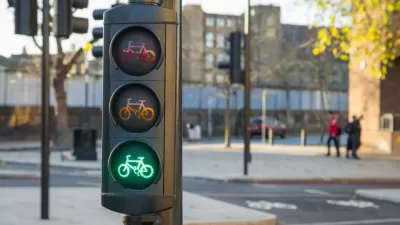Downtown Seattle is doing something right to get drivers out of cars: a recent survey reveals that fewer and fewer commuters are driving alone, and the fastest growing modes for commuters are of the non-motorized variety.
"Commute Seattle released new survey data,with the help of EMC Research [pdf], that shows a growing percentage of Downtown commuters rely on modes other than single occupancy vehicles (SOVs). In fact, 60% of commuters don’t drive at all, instead opting for transit, walking, or cycling," reports Owen Pickford.
"The mode split by type has changed significantly since the last survey, which was completed in 2012. Nearly 4% fewer people drove alone compared to that survey and it seems likely that Seattle will reach its goal of 30% or less by 2016."
There are drivers who probably wonder how those numbers can be true, but the city's increasing population means that the same number of drivers are on the road, even if they make up less of the overall mode share.
Yonah Freemark took to Twitter to note that the shift in mode share followed years of investment in Seattle's transit system. Writing for Streetsblog USA, Angie Schmitt notes that the data are "a testament to how quickly travel behavior can change..."
FULL STORY: Commute Seattle Study Shows Only 31% of Downtown Commuters Drive Alone

Alabama: Trump Terminates Settlements for Black Communities Harmed By Raw Sewage
Trump deemed the landmark civil rights agreement “illegal DEI and environmental justice policy.”

Study: Maui’s Plan to Convert Vacation Rentals to Long-Term Housing Could Cause Nearly $1 Billion Economic Loss
The plan would reduce visitor accommodation by 25% resulting in 1,900 jobs lost.

Why Should We Subsidize Public Transportation?
Many public transit agencies face financial stress due to rising costs, declining fare revenue, and declining subsidies. Transit advocates must provide a strong business case for increasing public transit funding.

Wind Energy on the Rise Despite Federal Policy Reversal
The Trump administration is revoking federal support for renewable energy, but demand for new projects continues unabated.

Passengers Flock to Caltrain After Electrification
The new electric trains are running faster and more reliably, leading to strong ridership growth on the Bay Area rail system.

Texas Churches Rally Behind ‘Yes in God’s Back Yard’ Legislation
Religious leaders want the state to reduce zoning regulations to streamline leasing church-owned land to housing developers.
Urban Design for Planners 1: Software Tools
This six-course series explores essential urban design concepts using open source software and equips planners with the tools they need to participate fully in the urban design process.
Planning for Universal Design
Learn the tools for implementing Universal Design in planning regulations.
Caltrans
Smith Gee Studio
Institute for Housing and Urban Development Studies (IHS)
City of Grandview
Harvard GSD Executive Education
Toledo-Lucas County Plan Commissions
Salt Lake City
NYU Wagner Graduate School of Public Service




























